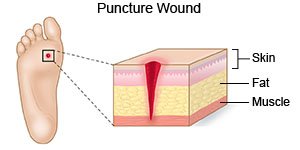Puncture Wounds in Children
Medically reviewed by Drugs.com. Last updated on Aug 4, 2025.
A puncture wound is a hole in your child's skin made by a sharp, pointed object. The area may be bruised or swollen. Your child may have bleeding, pain, or trouble moving the affected area.
 |
DISCHARGE INSTRUCTIONS:
Return to the emergency department if:
- Your child has severe pain.
- Your child has numbness or tingling in the area of his or her wound.
- Your child's wound starts bleeding and does not stop, even after you apply pressure.
Call your child's doctor if:
- Your child has new drainage or a bad odor coming from the wound.
- Your child has a fever or chills.
- Your child has increased swelling, redness, or pain.
- Your child has red streaks on his or her skin coming from the wound.
- You have questions or concerns about your child's condition or care.
Medicines:
Your child may need any of the following:
- NSAIDs , such as ibuprofen, help decrease swelling, pain, and fever. This medicine is available with or without a doctor's order. NSAIDs can cause stomach bleeding or kidney problems in certain people. If your child takes blood thinner medicine, always ask if NSAIDs are safe for him or her. Always read the medicine label and follow directions. Do not give these medicines to children younger than 6 months without direction from a healthcare provider.
- Antibiotics help prevent a bacterial infection.
- Do not give aspirin to children younger than 18 years. Your child could develop Reye syndrome if he or she has the flu or a fever and takes aspirin. Reye syndrome can cause life-threatening brain and liver damage. Check your child's medicine labels for aspirin or salicylates.
- Give your child's medicine as directed. Contact your child's healthcare provider if you think the medicine is not working as expected. Tell the provider if your child is allergic to any medicine. Keep a current list of the medicines, vitamins, and herbs your child takes. Include the amounts, and when, how, and why they are taken. Bring the list or the medicines in their containers to follow-up visits. Carry your child's medicine list with you in case of an emergency.
Care for your child's wound as directed:
Keep your child's wound clean and dry. When he or she is allowed to bathe, carefully wash the wound with soap and water. Dry the area and put on new, clean bandages as directed. Change your child's bandages when they get wet or dirty.
Elevate your child's injured area
above the level of his or her heart, if possible, as often as you can. This will help decrease swelling and pain. Prop the injured area on pillows or blankets to keep it elevated comfortably.
Follow up with your child's doctor in 2 to 3 days:
Write down your questions so you remember to ask them during your visits.
© Copyright Merative 2025 Information is for End User's use only and may not be sold, redistributed or otherwise used for commercial purposes.
The above information is an educational aid only. It is not intended as medical advice for individual conditions or treatments. Talk to your doctor, nurse or pharmacist before following any medical regimen to see if it is safe and effective for you.
Further information
Always consult your healthcare provider to ensure the information displayed on this page applies to your personal circumstances.
